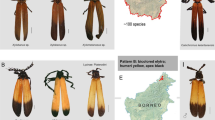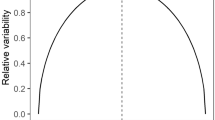Abstract
Instances of strikingly accurate Batesian mimicry (in which a palatable prey organism closely resembles an aversive model) are often cited to illustrate the power of natural selection1. Less attention has been paid to those mimics, such as many hoverfly (Syrphidae) mimics of wasps or bees, that resemble their models only poorly2,3,4. Attempts to provide an adaptive explanation for imperfect mimicry have suggested that what seems a crude resemblance to human observers may appear a close match to predators2, or that inaccurate mimics may bear a general resemblance to several different model species3,4. I show here, however, that truly inaccurate mimicry of a single model organism may be favoured over perfect resemblance, by kin selection. Signal detection theory predicts that predators will modify their level of discrimination adaptively in response to the relative frequencies and similarity of models and mimics5,6,7. If models are rare and/or weakly aversive, greater local similarity of mimics can thus lead to greater attack rates. Where individual mimics are related to others in their vicinity, kin selection will then oppose the evolution of accurate mimicry.
This is a preview of subscription content, access via your institution
Access options
Subscribe to this journal
Receive 51 print issues and online access
$199.00 per year
only $3.90 per issue
Buy this article
- Purchase on Springer Link
- Instant access to full article PDF
Prices may be subject to local taxes which are calculated during checkout



Similar content being viewed by others
References
Wickler, W. Mimicry in Plants and Animals (Weidenfeld & Nicholson, London, 1968)
Dittrich, W., Gilbert, F., Green, P., McGregor, P. & Grewcock, D. Imperfect mimicry: a pigeon's perspective. Proc. R. Soc. Lond. B 251, 195–200 (1993)
Howse, P. E. & Allen, J. A. Satyric mimicry: the evolution of apparent imperfection. Proc. R. Soc. Lond. B 257, 111–114 (1994)
Edmunds, M. Why are there good and poor mimics? Biol. J. Linn. Soc. 70, 459–466 (2000)
Duncan, C. J. & Sheppard, P. M. Sensory discrimination and its role in the evolution of Batesian mimicry. Behaviour 24, 269–282 (1965)
Getty, T. Discriminability and the sigmoid functional response: how optimal foragers could stabilise model-mimic complexes. Am. Nat. 125, 239–256 (1985)
Greenwood, J. J. D. Crypsis, mimicry and switching by optimal foragers. Am. Nat. 128, 294–300 (1986)
Fisher, R. A. The Genetical Theory of Natural Selection (Clarendon, Oxford, 1930)
Gittleman, J. L. & Harvey, P. H. Why are distasteful prey not cryptic? Nature 286, 149–150 (1980)
Harvey, P. H. & Paxton, R. J. The evolution of aposematic coloration. Oikos 37, 391–393 (1981)
Guilford, T. The evolution of conspicuous coloration. Am. Nat. 131, S7–S21 (1988)
Frank, S. A. Foundations of Social Evolution (Princeton Univ. Press, Princeton, 1998)
Rodríguez-Gironés, M. A. & Lotem, A. How to detect a cuckoo-egg: a signal-detection theory model for recognition and learning. Am. Nat. 153, 633–648 (1999)
Pilecki, C. & O'Donald, P. The effects of predation on artificial mimetic polymorphisms with perfect and imperfect mimics at varying frequencies. Evolution 25, 365–370 (1971)
Hetz, M. & Slobodchikoff, C. N. Predation pressure on an imperfect Batesian mimicry complex in the presence of alternative prey. Oecologia 76, 570–573 (1988)
Lindström, L., Alatalo, R. V. & Mappes, J. Imperfect Batesian mimicry—the effects of the frequency and the distastefulness of the model. Proc. R. Soc. Lond. B 264, 149–153 (1997)
Mappes, J. & Alatalo, R. V. Batesian mimicry and signal accuracy. Evolution 51, 2050–2053 (1997)
Brower, J. V. Z. Experimental studies of mimicry. IV. The reactions of starlings to different proportions of models and mimics. Am. Nat. 94, 271–282 (1960)
Lea, R. G. & Turner, J. R. G. Experiments on mimicry: II. The effect of a Batesian mimic on its model. Behaviour 42, 131–151 (1972)
Goodale, M. A. & Sneddon, I. The effect of distastefulness of the model on the predation of artificial Batesian mimics. Anim. Behav. 25, 660–665 (1977)
Pfennig, D. W., Harcombe, W. R. & Pfennig, K. S. Frequency-dependent Batesian mimicry. Nature 410, 323 (2001)
Acknowledgements
I thank R. Bshary, S. Dall, T. Getty, A. Lotem, S. Rands and A. Russell for comments and discussion.
Author information
Authors and Affiliations
Corresponding author
Ethics declarations
Competing interests
The authors declare that they have no competing financial interests.
Rights and permissions
About this article
Cite this article
Johnstone, R. The evolution of inaccurate mimics. Nature 418, 524–526 (2002). https://doi.org/10.1038/nature00845
Received:
Accepted:
Issue Date:
DOI: https://doi.org/10.1038/nature00845
This article is cited by
-
On the sparrowhawk-like calls of female common cuckoos: testing for heterospecific vocal mimicry in a conspecific functional context
Behavioral Ecology and Sociobiology (2023)
-
Body size in Batesian mimicry
Evolutionary Ecology (2023)
-
When animal coloration is a poor match
Evolutionary Ecology (2021)
-
Coral snakes predict the evolution of mimicry across New World snakes
Nature Communications (2016)
-
Multi-trait mimicry of ants by a parasitoid wasp
Scientific Reports (2015)
Comments
By submitting a comment you agree to abide by our Terms and Community Guidelines. If you find something abusive or that does not comply with our terms or guidelines please flag it as inappropriate.



